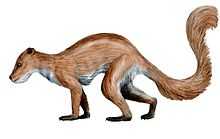Plesiadapiformes
| Plesiadapiformes Temporal range: Paleocene–Eocene | |
|---|---|
 | |
| Plesiadapis | |
| Scientific classification | |
| Kingdom: | Animalia |
| Phylum: | Chordata |
| Class: | Mammalia |
| Mirorder: | Primatomorpha |
| Order: | †Plesiadapiformes |
| Families | |
| |
Plesiadapiformes ("Adapid-like" or "near Adapiformes") is an extinct (and possibly paraphyletic or polyphyletic[1] [2] [3] ) order of mammals. It is either closely related to the primates or a precursor to them. Many are too derived to be ancestral to primates, but the earliest Plesiadapiformes have teeth that are strongly indicative of a common ancestor. Purgatorius is believed to be close to the last common ancestor of primates and Plesiadapiformes.
Plesiadapiformes first appear in the fossil record between 65 and 55 million years ago,[4] though many were extinct by the beginning of the Eocene. It is possible that they are the first mammals to have developed finger nails in place of claws.[5]
| Euarchontoglires |
| ||||||||||||||||||||||||||||||
| |
One possible classification table of plesiadapiform families is listed below.
- ORDER PLESIADAPIFORMES
- Family Micromomyidae
- Superfamily Paromomyoidea
- Family Paromomyidae
- Family Picromomyidae
- Family Palaechthonidae
- Family Picrodontidae
- Family Microsyopidae
- Superfamily Plesiadapoidea
- Family Chronolestidae
- Family Plesiadapidae
- Superfamily Carpolestoidea
- Family Carpolestidae
References
- ↑ Henke, Winfried; Tattersall, Ian; Hardt, Thorolf (2007). Handbook of Paleoanthropology: Vol I:Principles, Methods and Approaches Vol II:Primate Evolution and Human Origins Vol III:Phylogeny of Hominids. Springer Science & Business Media. p. 839. ISBN 978-3-540-32474-4. Retrieved 25 January 2015.
- ↑ Boyer, Doug M.; Costeur, Loïc; Lipman, Yaron (2012). "Earliest record of Platychoerops(Primates, Plesiadapidae), a new species from Mouras Quarry, Mont de Berru, France". American Journal of Physical Anthropology 149 (3): 329–346. doi:10.1002/ajpa.22119. ISSN 0002-9483.
- ↑ Ni, X.; Meng, J.; Beard, K. C.; Gebo, D. L.; Wang, Y.; Li, C. (2009). "A new tarkadectine primate from the Eocene of Inner Mongolia, China: phylogenetic and biogeographic implications". Proceedings of the Royal Society B: Biological Sciences 277 (1679): 247–256. doi:10.1098/rspb.2009.0173. ISSN 0962-8452. PMC 2842661. PMID 19386655.
- ↑ Paleontologists discover most primitive primate skeleton - PhysOrg.com
- ↑ ""Sleep, First Primates, Earthquakes in the Midwest and Profile: Sang-Mook Lee"". NOVA scienceNOW. Season 4. Episode 8http://www.pbs.org/wgbh/nova/transcripts/0303_sciencen.html#h02
|transcripturl=missing title (help). 1 September 2009. 13:04 minutes in. PBS.